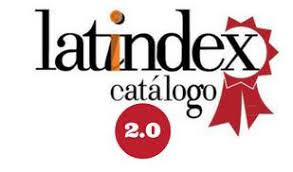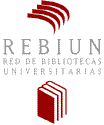Impacto de la morfología del vecindario en el clima tropical: un estudio de caso de los barrios tradicionales de Kanyakumari, India
DOI:
https://doi.org/10.22320/07190700.2025.15.01.02Palabras clave:
morfología, zona residencial, clima, zonas tropicalesResumen
La morfología del entorno construido interactúa con el ambiente térmico circundante. Las interacciones térmicas afectan la demanda energética y el confort térmico de un vecindario. Las temperaturas extremas debido al cambio climático exigen una intervención para reciprocar la calefacción urbana. Por lo tanto, este estudio analizó la interacción térmica entre la morfología y el ambiente térmico. El estudio se llevó a cabo en la ciudad tropical de Kanyakumari, en la India. Se estudió la influencia de la relación de aspecto, el factor de vista del cielo, la relación de cubierta verde y la relación de cubierta edificada en el Índice Climático Térmico Universal. Se realizó un análisis cuantitativo de las variables morfológicas para establecer una relación con la variable de confort. Las relaciones de aspecto y cubierta verde se correlacionaron positivamente con el índice climático; por el contrario, el factor de vista del cielo y la relación de cubierta edificada tuvieron una relación negativa con el índice. Sin embargo, cuando se introdujo vegetación en las calles, la interacción entre la relación de aspecto y el índice se invirtió. Un aumento en la relación de aspecto redujo el confort en el cañón al introducir vegetación.
Descargas
Citas
BETTI, G., TARTARINI, F., NGUYEN, C., & SCHIAVON, S. (2024). CBE Clima Tool: a free and open-source web application for climate analysis tailored to sustainable building design. Building Simulation, 17(3), 493-5008. https://doi.org/10.1007/s12273-023-1090-5 DOI: https://doi.org/10.1007/s12273-023-1090-5
BOUKHABLA, M., ALKAMA, D., & BOUCHAIR, A. (2013). The effect of urban morphology on urban heat island in the city of Biskra in Algeria. International Journal of Ambient Energy, 34(2), 100–110. https://doi.org/10.1080/01430750.2012.740424 DOI: https://doi.org/10.1080/01430750.2012.740424
Bureau of Energy Efficiency. (2023). Impact of Energy Efficiency Measures For The Year 2021-22. https://udit.beeindia.gov.in/wp-content/uploads/2024/02/Impact-Assessment-Report-2021-22-1.pdf
CHEN, G., WANG, D., WANG, Q., LI, Y., WANG, X., HANG, J., GAO, P., OU, C., & WANG, K. (2020). Scaled outdoor experimental studies of urban thermal environment in street canyon models with various aspect ratios and thermal storage. Science of the Total Environment, 726, 138147. https://doi.org/10.1016/j.scitotenv.2020.138147 DOI: https://doi.org/10.1016/j.scitotenv.2020.138147
CHEN, S., ZHANG, W., HIEN, N., & IGNATIUS, M. (2020). Combining CityGML files and data-driven models for microclimate simulations in a tropical city. Building and Environment, 185, 107314. https://doi.org/10.1016/j.buildenv.2020.107314 DOI: https://doi.org/10.1016/j.buildenv.2020.107314
DE, B., & MUKHERJEE, M. (2018). "Optimisation of canyon orientation and aspect ratio in warm-humid climate: Case of Rajarhat Newtown, India". Urban Climate, 24, 887–920. https://doi.org/10.1016/j.uclim.2017.11.003 DOI: https://doi.org/10.1016/j.uclim.2017.11.003
EMMANUEL, R., & FERNANDO, H. J. S. (2007). Urban heat islands in humid and arid climates: Role of urban form and thermal properties in Colombo, Sri Lanka, and Phoenix, USA. Climate Research, 34, 241–251. https://doi.org/10.3354/cr00694 DOI: https://doi.org/10.3354/cr00694
EMMANUEL, R., & JOHANSSON, E. (2006). Influence of urban morphology and sea breeze on hot humid microclimate: The case of Colombo, Sri Lanka. Climate Research, 30, 189–200. https://doi.org/10.3354/cr030189 DOI: https://doi.org/10.3354/cr030189
GOLANY, G. S. (1996). Urban design morphology and thermal performance. Atmospheric Environment, 30(3), 455–465. https://doi.org/10.1016/1352-2310(95)00266-9 DOI: https://doi.org/10.1016/1352-2310(95)00266-9
JAMEI, E., OSSEN, D. R., SEYEDMAHMOUDIAN, M., SANDANAYAKE, M., STOJCEVSKI, A., & HORAN, B. (2020). Urban design parameters for heat mitigation in tropics. Renewable and Sustainable Energy Reviews, 134, 110362. https://doi.org/10.1016/j.rser.2020.110362 DOI: https://doi.org/10.1016/j.rser.2020.110362
JASP Team. (2024). JASP (Version 0.19.2) [Computer software]. https://jasp-stats.org/
JOHANSSON, E., EMMANUEL, R., & ROSENLUND, H. (September 19–22 2004). Microclimate and thermal comfort in the warm humid city of Colombo, Sri Lanka. Plea2004 - The 21th Conference on Passive and Low Energy Architecture. Eindhoven, The Netherlands. https://alexandria.tue.nl/openaccess/635611/p0661final.pdf
JUSUF, S. K., & HIEN, W. N. (2012). Development of empirical models for an estate-level air temperature prediction in Singapore. Journal of Heat Island Institute International, 7-2, 111-125. https://heat-island.jp/web_journal/HI2009Conf/pdf/15.pdf
KRÜGER, E., & GIVONI, B. (2007). Outdoor measurements and temperature comparisons of seven monitoring stations: Preliminary studies in Curitiba, Brazil. Building and Environment, 42(4), 1685–1698. https://doi.org/10.1016/j.buildenv.2006.02.019 DOI: https://doi.org/10.1016/j.buildenv.2006.02.019
LASSANDRO, P., DI TURI, S., & ZACCARO, S. A. (2019). Mitigation of rising urban temperatures starting from historic and modern street canyons towards zero energy settlement. IOP Conference Series: Materials Science and Engineering, 609(7), 072036. https://doi.org/10.1088/1757-899X/609/7/072036 DOI: https://doi.org/10.1088/1757-899X/609/7/072036
NBC. (2016). National Building Code of india 2016 Volumen 2. Bureau of Indian Standards. https://dn790000.ca.archive.org/0/items/nationalbuilding02/in.gov.nbc.2016.vol2.digital.pdf
OKE, T. R. (1982). The energetic basis of the urban heat island. Quarterly Journal of the Royal Meteorological Society, 108(455), 1–24. https://doi.org/10.1002/qj.49710845502 DOI: https://doi.org/10.1002/qj.49710845502
OKE, T. R., JOHNSON, G. T., STEYN, D. G., & WATSON, I. D. (1991). Simulation of surface urban heat islands under “ideal” conditions at night, part 2: Diagnosis of causation. Boundary-Layer Meteorology, 56, 339–358. https://doi.org/10.1007/BF00119211 DOI: https://doi.org/10.1007/BF00119211
OUYANG, W., LIU, Z., LAU, K., SHI, Y., & NG, E. (2022). Comparing different recalibrated methods for estimating mean radiant temperature in outdoor environment. Building and Environment, 216, 109004. https://doi.org/10.1016/j.buildenv.2022.109004 DOI: https://doi.org/10.1016/j.buildenv.2022.109004
PATTACINI, L. (2012). Climate and urban form. Urban Design International, 17, 106–114. https://doi.org/10.1057/udi.2012.2 DOI: https://doi.org/10.1057/udi.2012.2
SHAFAGHAT, A., MANTEGHI, G., KEYVANFAR, A., BIN LAMIT, H., SAITO, K., & OSSEN, D. R. (2016). Street geometry factors influence urban microclimate in tropical coastal cities: A review. Environmental and Climate Technologies, 17(1), 61–75. https://doi.org/10.1515/rtuect-2016-0006 DOI: https://doi.org/10.1515/rtuect-2016-0006
SHANKAR, M., & MARWAHA, B. M. (2023). Impact of courtyard on indoor thermal environment in vernacular row houses of warm and humid climate: case study of Kanyakumari, Tamil Nadu. Advances in Building Energy Research, 17(6), 653–678. https://doi.org/10.1080/17512549.2023.2290529 DOI: https://doi.org/10.1080/17512549.2023.2290529
SHANKAR, M., & SUNDARAM, A. M. (2023). Efficient and optimum design of native architecture – A means for sustainability. Case study of Residential Units in Kottar, Kanyakumari. Energy & Buildings, 298, 113586. https://doi.org/10.1016/j.enbuild.2023.113586 DOI: https://doi.org/10.1016/j.enbuild.2023.113586
SHARMIN, T., STEEMERS, K., & HUMPHREYS, M. (2019). Outdoor thermal comfort and summer PET range: A field study in tropical city Dhaka. Energy and Buildings, 198, 149–159. https://doi.org/10.1016/j.enbuild.2019.05.064 DOI: https://doi.org/10.1016/j.enbuild.2019.05.064
SUN, C. Y. (2011). A street thermal environment study in summer by the mobile transect technique. Theoretical and Applied Climatology, 106, 433–442. https://doi.org/10.1007/s00704-011-0444-6 DOI: https://doi.org/10.1007/s00704-011-0444-6
TSOKA, S., TSIKALOUDAKI, K., & THEODOSIOU, T. (2017). Urban space’s morphology and microclimatic analysis: A study for a typical urban district in the Mediterranean city of Thessaloniki, Greece. Energy and Buildings, 156, 96–108. https://doi.org/10.1016/j.enbuild.2017.09.066 DOI: https://doi.org/10.1016/j.enbuild.2017.09.066
TSOKA, S., TSIKALOUDAKI, K., THEODOSIOU, T., & BIKAS, D. (2020). Assessing the effect of the urban morphology on the ambient air temperature of urban street canyons under different meteorological conditions. Application in residential areas of Thessaloniki, Greece. IOP Conference Series: Earth and Environmental Science, 410, 012005. https://doi.org/10.1088/1755-1315/410/1/012005 DOI: https://doi.org/10.1088/1755-1315/410/1/012005
VANOS, J. K., RYKACZEWSKI, K., MIDDEL, A., VECELLIO, D. J., BROWN, R. D., & GILLESPIE, T. J. (2021). Improved methods for estimating mean radiant temperature in hot and sunny outdoor settings. International Journal of Biometeorology, 65, 967–983. https://doi.org/10.1007/s00484-021-02131-y DOI: https://doi.org/10.1007/s00484-021-02131-y
YU, Z., CHEN, S., WONG, N. H., IGNATIUS, M., DENG, J., HE, Y., & HII, D. J. C. (2020). Dependence between urban morphology and outdoor air temperature: A tropical campus study using random forests algorithm. Sustainable Cities and Society, 61, 102200. https://doi.org/10.1016/j.scs.2020.102200 DOI: https://doi.org/10.1016/j.scs.2020.102200
ZHOU, H., TAO, G., YAN, X., & SUN, J. (2021). Influences of greening and structures on urban thermal environments: A case study in Xuzhou City, China. Urban Forestry and Urban Greening, 66, 127386. https://doi.org/10.1016/j.ufug.2021.127386 DOI: https://doi.org/10.1016/j.ufug.2021.127386
ZHU, S., CHEN, M., LU, S., & MAI, X. (2022). Influence of Urban Geometry on Thermal Environment of Urban Street Canyons in Hong Kong. Buildings, 12(11), 1836. https://doi.org/10.3390/buildings12111836 DOI: https://doi.org/10.3390/buildings12111836
Descargas
Publicado
Cómo citar
Número
Sección
Licencia
Derechos de autor 2025 Monika Shankar, A. Meenatchi Sundaram

Esta obra está bajo una licencia internacional Creative Commons Atribución-CompartirIgual 4.0.
El contenido de los artículos que se publican en cada número de Hábitat Sustentable, es responsabilidad exclusiva de los autores y no representan necesariamente el pensamiento ni comprometen la opinión de la Universidad del Bío-Bío.
Los autores/as conservarán sus derechos de autor y garantizarán a la revista el derecho de primera publicación de su obra, el cuál estará simultáneamente sujeto a la Licencia de Reconocimiento de Creative Commons CC BY-SA que permite a otros compartir-copiar, transformar o crear nuevo material a partir de esta obra con fines no comerciales, siempre y cuando se reconozcan la autoría y la primera publicación en esta revista, y sus nuevas creaciones estén bajo una licencia con los mismos términos.

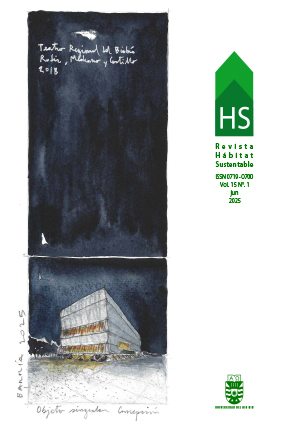
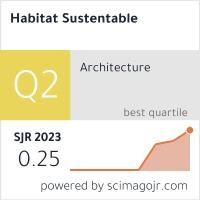








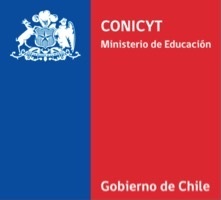 Programa de Información Científica/Concurso Fondos de Publicación de Revistas Científicas 2018/ Proyecto Mejoramiento de Visibilidad de Revistas UBB (Código:FP180007)
Programa de Información Científica/Concurso Fondos de Publicación de Revistas Científicas 2018/ Proyecto Mejoramiento de Visibilidad de Revistas UBB (Código:FP180007) 
